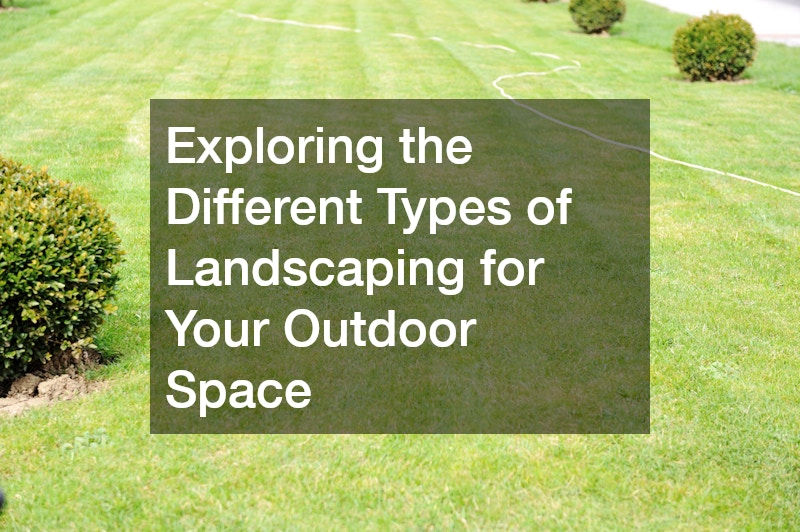In this article, we will delve into the diverse world of landscaping, exploring various styles and techniques to transform your outdoor space. Whether you’re a beginner or an experienced landscaper, understanding the different types of landscaping can help you make informed decisions for your garden or yard. Exploring these types of landscaping will also assist you in collaborating effectively with a local tree service or a landscape installation company.
From traditional garden layouts to modern, sustainable designs, we will cover the essential elements that contribute to a beautiful and functional outdoor environment. Additionally, we’ll discuss how factors such as climate, soil quality, and maintenance needs play a crucial role in selecting the right landscaping approach. By the end of this article, you’ll have a clearer vision of how to enhance your outdoor space while balancing aesthetics and practicality.
We will also explore the use of hardscaping elements, such as patios, walkways, and retaining walls, which can add structure and durability to your landscape. Moreover, incorporating native plants and water-efficient designs can help create an eco-friendly yard that thrives with minimal maintenance. Whether you’re interested in a lush, tropical garden, a minimalist rock landscape, or a wildlife-friendly habitat, there are endless possibilities to suit your taste and lifestyle.
Additionally, it’s important to consider how landscaping choices may impact your homeowners insurance. Certain features, such as large trees, pools, or outdoor structures, can influence your policy coverage and premiums. Properly maintaining your landscape can help reduce potential risks, such as tree damage or fire hazards, which could affect your insurance rates. With the right planning and creativity, your outdoor space can become a beautiful retreat that enhances your home’s curb appeal, increases its value, and aligns with your insurance considerations.
1. What Are the Basic Types of Landscaping?

The basic types of landscaping can be broadly categorized into two main types: softscaping and hardscaping. Softscaping involves the use of living plant materials like flowers, shrubs, and trees, and relies heavily on the expertise of a landscaper who appreciates natural aesthetic beauty. A local tree service can play a significant role in effective softscaping by ensuring healthy tree care solutions.
Hardscaping, on the other hand, focuses on the non-living components of your landscape. This could include pathways, patios, and wall structures-essentially, all the elements that provide physical structure to the garden. Engaging a skilled landscape designer can help you seamlessly blend both softscape and hardscape elements for a balanced outdoor space.
Another type of landscaping that has gained popularity is sustainable landscaping. Sustainable landscaping focuses on environmentally friendly practices that conserve resources and minimize pollution. Many different types of landscaping practices can be altered to adopt more sustainable approaches, making this a versatile and adaptable style.
2. How Does Hardscaping Differ From Softscaping?
Hardscaping and softscaping are two very different components of landscape design. Hardscaping involves man-made features such as walkways, stone walls, and decks that provide functional and aesthetic benefits. These elements require thoughtful planning and often necessitate professional expertise from a local tree removal contractor to integrate seamlessly with plant life.
Softscaping, conversely, focuses on all things green and growing-trees, shrubs, plants, flowers, and grass. It’s essential for homeowners to consider the local climate and soil conditions, as these factors greatly influence plant growth and health. Softscaping requires ongoing maintenance such as regular watering, fertilization, and pruning, tasks that can be supported by a reliable local tree service.
While hardscaping usually involves more upfront planning and investment, it often requires less ongoing maintenance compared to softscaping. Homeowners can benefit from both elements, using various types to create a comprehensive and cohesive environment. Balancing these two types ensures that your space is both functional and visually harmonious, with plant choices accentuating man-made structures.
3. What Is Sustainable Landscaping and Why Is It Important?
Sustainable landscaping is an approach that attempts to create an environmentally considerate landscape by minimizing resource use and pollution. This type of design often incorporates native plants, which require less water and maintenance, making it a practical choice for homeowners. Partnering with a landscape designer who understands sustainable practices can ensure effective landscape installation that meets ecological standards.
Sustainable landscaping also emphasizes biodiversity, promoting a healthy ecosystem. Incorporating different types of landscaping within a sustainable framework ensures the long-term viability of your outdoor space. This aspect of sustainability can also influence property value, potentially giving you an advantage in any future land sale.
The importance of sustainable landscaping is further underscored by the ongoing effects of climate change. By choosing environmentally friendly practices, homeowners can reduce their carbon footprint and promote the health of local flora and fauna. Such an approach ensures both immediate benefits and long-term conservation efforts.
4. What Are the Benefits of Xeriscaping?

Xeriscaping is one of the different types of landscaping that focuses on reducing water usage. This approach utilizes drought-tolerant plants and efficient irrigation techniques, making it ideal for arid regions or areas experiencing water restrictions. Homeowners opting for a xeriscaped garden can significantly decrease water consumption, thus lowering their utility bills.
Beyond cost savings, xeriscaping provides a unique aesthetic appeal that can enhance the overall beauty of your property. The use of a local tree removal contractor can help you select and plant trees that complement drought-resistant shrubs and flowering plants. This approach results in a cohesive, beautiful design that is as functional as it is attractive.
Incorporating xeriscaping into your landscape also supports local ecosystems by utilizing native plant species. These plants require less maintenance and are naturally resilient to local pests and weather conditions. The reduced need for water and fertilizers makes xeriscaping an appealing option for environmentally conscious homeowners.
5. How Is Japanese Garden Landscaping Implemented?
Japanese garden landscaping is a traditional design style that aims to replicate natural landscapes on a miniature scale. Elements such as water features, rocks, and minimalist plantings are common characteristics of this style. A local tree service can assist in shaping trees and shrubs to enhance the aesthetic value and authenticity of a Japanese garden.
This type of landscaping often employs the principle of asymmetry, providing a natural look that feels both structured and free-form. Stone pathways, zen sand gardens, and well-placed water elements create a serene and meditative environment. Integrating a few Japanese ornamental trees and plants can enhance tranquility and balance.
To successfully achieve a Japanese landscape design, careful planning and a thoughtful approach to space and setting are required. Employing a knowledgeable landscape designer can help guide the choice of materials and plants. Attention to detail is critical, as each element must harmonize with the overall landscape.
6. What Are the Key Features of Mediterranean Landscaping?
Mediterranean landscaping is characterized by warm, earthy tones and an emphasis on outdoor living spaces. Key features include terracotta pots, open courtyards, and stone pathways. The use of fragrant herbs and flowering plants enhances the sensory experience of the landscape.
Colorful tiles, water features, and shaded terraces make Mediterranean gardens unique and inviting. The style integrates both softscape and hardscape elements, requiring careful coordination through experienced landscape installation practices. A local tree service can help maintain olive trees, cypress, and other characteristic plants of Mediterranean landscaping.
This landscaping style is inspired by countries such as Spain, Greece, and Italy, and its timeless aesthetic is coupled with functionality. Mediterranean landscapes maximize outdoor living opportunities, making this a popular choice for house and land package designs. The style can easily adapt to modern landscape elements while preserving traditional design cues.
7. How Do You Design a Wildlife-Friendly Landscape?

Designing a wildlife-friendly landscape involves creating spaces that invite and support local fauna. This includes selecting native plant species that provide food and shelter for birds, insects, and small animals. Consulting with a landscaper knowledgeable in these species can enhance the effectiveness of a wildlife-friendly landscape.
To attract wildlife, elements such as bird feeders, water sources, and nesting boxes can be integrated. Minimizing pesticide and herbicide use is also crucial for sustaining healthy populations of beneficial insects. Creating densely planted areas offers safe havens for various creatures, encouraging biodiversity.
Incorporating different types of landscaping, such as meadow plants or woodland settings, can further support wildlife needs. A collaborative approach with local tree service professionals will ensure native trees and shrubs are selected for maximum ecological benefit. Such thoughtful landscaping not only boosts ecological health but also offers delightful observational opportunities.
8. What Is Tropical Landscaping and How Can It Be Achieved?
Tropical landscaping is characterized by lush, verdant foliage and vibrant floral displays, often recreating the feel of a rainforest. Key elements include large-leafed plants, water features, and dynamic color contrasts. A local tree removal contractor can assist in appropriately designing and maintaining such lush landscapes through strategic planting and pruning.
This type of landscaping requires a climate that can support the growth of tropical plants, or the use of shade structures and misting systems to simulate a humid environment. Palms, orchids, and bamboo are popular plants in these gardens. Such landscapes offer homeowners an exotic aesthetic, often enhancing spaces for relaxation and entertainment.
Tropical garden design is versatile, incorporating elements like hammocks, water features, and brightly colored furnishings to enhance the ambiance. An experienced landscape designer can balance the elements of water, plant choice, and shade structures to optimize the lush, inviting nature of a tropical landscape. This type of landscaping requires thoughtful water management to maintain plant health and sustainability.
9. How Can Modern Landscaping Be Incorporated Into an Outdoor Space?
Modern landscaping often features a minimalist design with clean lines and open spaces. It emphasizes functionality and contemporary aesthetics, often using innovative materials and techniques. These spaces are often enhanced by engaging a landscape designer experienced in modern functionality.
Characteristic elements of modern landscaping include geometric shapes, structured plantings, and the use of diverse textures and materials. Elements such as concrete, glass, and steel are often employed to create striking visual impact. Water features with clean lines, outdoor kitchens, and strategically placed lighting extend usability beyond daylight hours.
Modern landscaping aims to balance form and function, making it ideal for active lifestyles. Native plants often play a significant role in maintaining low maintenance and sustainable practices. The flexibility of modern landscaping makes it an attractive choice for integrating with any existing landscape features or new developments, such as house and land package options.
10. What Role Do Native Plants Play in Landscaping?

Native plants are integral to many different types of landscaping because they are naturally adapted to the local climate and soil conditions. This means they require less maintenance, less water, and fewer fertilizers, making them an eco-friendly choice. A professional landscaper with knowledge of local flora can greatly aid in the selection and installation of native plants.
By using native plants, homeowners can support local biodiversity. These plants provide natural habitats and food sources for local wildlife, promoting healthy ecosystems. Local tree service experts can assist in selecting and maintaining trees that integrate well with other native plants in your landscape.
The stability of native plants increases the resilience of a landscape to pests and diseases. Their integration into various types of landscaping offers both ecological and aesthetic advantages. Native plants can also be a selling point in future land sale considerations, highlighting sustainable practices to prospective buyers.
Landscaping offers a myriad of possibilities to beautify and personalize your outdoor space. By exploring different styles and techniques, you can create a landscape that enhances aesthetic appeal and meets functional needs. Whether you choose to integrate elements from several landscaping types or focus on a specific style, the landscaping journey is a rewarding endeavor that adds value to your home and enjoyment to your life. The diverse landscaping types we’ve discussed- from sustainable to tropical, from modern to wildlife-friendly-offer unique contributions to landscape design. Engaging services like local tree removal contractors or local house cleaning services can provide additional support in maintaining your chosen landscape. It is important to consider how each type can be harmoniously integrated with existing structures, whether part of a house and land package or a recently acquired land sale. With the various options available, understanding the roles of different types of landscaping, along with essential elements like tree care and sustainable practices, will equip you to make informed decisions. As you venture into the world of landscaping, remember to consult with professionals and rely on your creativity to create a space that feels both personal and harmonious.


